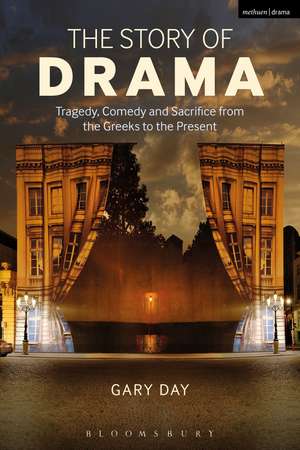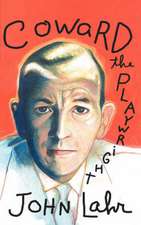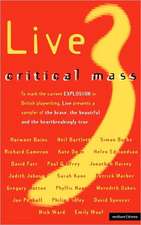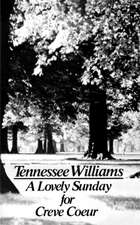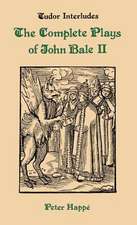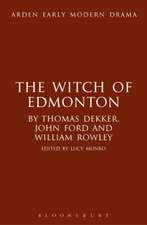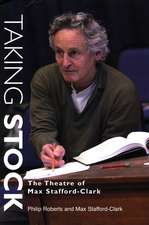The Story of Drama: Tragedy, Comedy and Sacrifice from the Greeks to the Present
Autor Dr Gary Dayen Limba Engleză Hardback – 24 aug 2016
| Toate formatele și edițiile | Preț | Express |
|---|---|---|
| Paperback (1) | 166.20 lei 22-36 zile | |
| Bloomsbury Publishing – 24 aug 2016 | 166.20 lei 22-36 zile | |
| Hardback (1) | 715.42 lei 43-57 zile | |
| Bloomsbury Publishing – 24 aug 2016 | 715.42 lei 43-57 zile |
Preț: 715.42 lei
Preț vechi: 915.94 lei
-22% Nou
Puncte Express: 1073
Preț estimativ în valută:
136.91€ • 142.07$ • 114.43£
136.91€ • 142.07$ • 114.43£
Carte tipărită la comandă
Livrare economică 17-31 martie
Preluare comenzi: 021 569.72.76
Specificații
ISBN-13: 9781408184158
ISBN-10: 140818415X
Pagini: 248
Dimensiuni: 156 x 234 x 16 mm
Greutate: 0.53 kg
Editura: Bloomsbury Publishing
Colecția Methuen Drama
Locul publicării:London, United Kingdom
ISBN-10: 140818415X
Pagini: 248
Dimensiuni: 156 x 234 x 16 mm
Greutate: 0.53 kg
Editura: Bloomsbury Publishing
Colecția Methuen Drama
Locul publicării:London, United Kingdom
Caracteristici
Uniquely considers developments in tragedy and comedy from the ancient Greeks to the present
Notă biografică
Gary Day recently retired as principal lecturer at De Montfort University, UK, where he taught courses on the history of drama, the eighteenth century, modernism, contemporary drama and contemporary fiction. He is the author of Literary Criticism: A New History (2008) and Modernist Literature: 1890-1950 (2010). He has edited a dozen books, the latest being The Wiley Encyclopaedia of British Eighteenth Century Literature (2015) with Jack Lynch. He has contributed to the Cambridge History of Literary Criticism and to the Oxford Guide to Literary Theory and Criticism. He has also been a regular columnist and reviewer for the Times Higher.
Cuprins
AcknowledgementsChapter 1: SacrificeChapter 2: Tragedy, Comedy and RitualChapter 3: Greek Tragedy and Comedy and SacrificeChapter 4: Roman Tragedy and Comedy and SacrificeChapter 5: Medieval Tragedy and ComedyChapter 6: Renaissance Tragedy and Comedy and SacrificeChapter 7: Restoration and Eighteenth Century Tragedy and Comedy and SacrificeChapter 8: Victorian Melodrama, Comedy, Naturalism and SacrificeChapter 9: Tragedy, Comedy and Sacrifice in the Twentieth and Twenty First CenturiesConclusion: Tragedy, Comedy and Sacrifice in Popular CultureNotes IndexAbout the Author
Recenzii
The Story of Drama is an ambitious book, richly informative, consistently readable and conscientiously argued.
[A] concise, valuable survey ... Its warm, conversational tone suggests that students on the De Montfort University course whose lectures informed this volume had a fine teacher indeed.
Definitely one for any sixth former doing Drama or Theatre Studies and for anyone teaching drama to any age group.
If you want to bone up on the history of drama ... then try Gary Day's very readable The Story of Drama which examines drama and how it has developed from the Greeks to the 21st century mostly through the themes of tragedy, comedy and sacrifice.
In helping us to rethink how we discuss theatre, Day is providing critics and educators a new set of tools with which to work . This book would be most useful in a script-analysis classroom as a way to begin interesting discussions about plays-or rather to rethink how we approach those discussions. Rather than asking 'What does this play mean?,' Day wants us to ask 'How does this play maintain social cohesion through sacrifice?'
Offers powerful insights into the workings of sacrifice in both tragic and comic modes of drama, and offers a wide set of historical examples of how sacrifice is embedded in both modes . The book's final chapters bring its insights together, offering the kind of critical depth and potential richness that reward close reading . Day's last chapter . builds a compelling case for how complexly the power of these deep-seated, ancient structures-ways of shaping the world and how we feel about it-are embedded in contemporary, popular sensibilities and entertainments . I am grateful to Gary Day for his labors in bringing these volcanic forces to light, showing how we might unbury them, and revealing how they persist in contemporary dramatic forms far from the ancient circumstances of their birth.
What is fascinating about this study is the way in which Day repositions familiar plays, using them as evidence of radical changes in our concepts of sacrifice and in the process casting new light on their well-worn pages . [A] solid work that should be especially useful in courses on script analysis, as well as in those that attempt to link the history of great dramas to the cultural contexts from which they emerge.
[A] concise, valuable survey ... Its warm, conversational tone suggests that students on the De Montfort University course whose lectures informed this volume had a fine teacher indeed.
Definitely one for any sixth former doing Drama or Theatre Studies and for anyone teaching drama to any age group.
If you want to bone up on the history of drama ... then try Gary Day's very readable The Story of Drama which examines drama and how it has developed from the Greeks to the 21st century mostly through the themes of tragedy, comedy and sacrifice.
In helping us to rethink how we discuss theatre, Day is providing critics and educators a new set of tools with which to work . This book would be most useful in a script-analysis classroom as a way to begin interesting discussions about plays-or rather to rethink how we approach those discussions. Rather than asking 'What does this play mean?,' Day wants us to ask 'How does this play maintain social cohesion through sacrifice?'
Offers powerful insights into the workings of sacrifice in both tragic and comic modes of drama, and offers a wide set of historical examples of how sacrifice is embedded in both modes . The book's final chapters bring its insights together, offering the kind of critical depth and potential richness that reward close reading . Day's last chapter . builds a compelling case for how complexly the power of these deep-seated, ancient structures-ways of shaping the world and how we feel about it-are embedded in contemporary, popular sensibilities and entertainments . I am grateful to Gary Day for his labors in bringing these volcanic forces to light, showing how we might unbury them, and revealing how they persist in contemporary dramatic forms far from the ancient circumstances of their birth.
What is fascinating about this study is the way in which Day repositions familiar plays, using them as evidence of radical changes in our concepts of sacrifice and in the process casting new light on their well-worn pages . [A] solid work that should be especially useful in courses on script analysis, as well as in those that attempt to link the history of great dramas to the cultural contexts from which they emerge.
